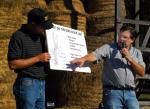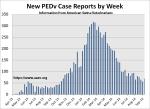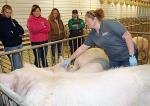COOK STATION, Mo. – Producers can learn strategies to stretch hay supplies, supplement poor-quality forage and renovate their pastures, and see a sawmill demonstration and more at the University of Missouri Wurdack Research Center’s annual field day Oct. 5. Tours start at 9 a.m. Free lunch will be provided after morning tours.
Nestled along the Meramec River in the northeastern Ozarks, the center conducts demonstrations and research in integrated livestock, forages, forestry, agroforestry and wildlife management practices for the Ozark region of Missouri. It’s part of a network of research centers across Missouri, extending the College of Agriculture, Food and Natural Resources’ (CAFNR) research to more than 14,000 acres to meet the regional research and demonstration needs of agricultural producers and natural resource managers.
Attendees can connect with University of Missouri experts at nine presentations throughout the day, including the following:
Herd Culling Strategies
Livestock producers across the Midwest have faced some tough decisions concerning their herds this summer, including deciding to cull. Ted Cunningham, livestock specialist for MU Extension, will discuss strategies to inform those difficult decisions to help producers get those most out of each ounce of forage and feed.
Cunningham recommends a pregnancy examination as one of the best tools to inform culling decisions. “Open cows, cows that don’t wean a good calf this fall and cows that have any type of defects should be first to go,” he said. “Look at your records and identify the lower-performing cows,” Cunningham added. “If they don’t fit your available resources it’s time to get rid of them or consider different management options.”
Cunningham will help produces make truly smart culling decisions to keep the highest percentage of productive cows in the herd based on feed resources. He’ll also share marketing strategies for culled cows.
Renovating Forages—What to do after the Drought
Sometimes, opportunity follows adversity. Will McClain, MU Extension agronomist, will share strategies for producers to improve pastures following the hot, dry summer. McClain said the first step for producers is to evaluate what they had prior to the drought. “Was it a good stand? If it was healthy and not grazed too hard it’s likely to return; forages are much more tolerant of drought than flooding. Many of the perennials that look dead will come back—if we get some rain this fall.”
“It’s important to consider your individual situation, but generally you’ll get more bang for your forage dollar if you fertilize vs. overseeding a winter forage,” he said.
McClain will discuss three options for improving pastures: fertilizing, planting winter annuals such as winter oats or rye as a quick fix, or completely renovating a pasture.
“This might be a good year to take a pasture out of production and plant a smother crop, spray in the spring and reseed with a better variety,” McClain said.
Improve Your Herd for Premium Profits
During lunch a new program designed to improve profitability of beef cow-calf operations, “Quality Beef by the Numbers,” will be discussed. Mike Kasten, program director, will describe the aims of the long-term program and how producers can get involved.
Quality Beef by the Numbers is a university and industry joint project to boost the supply of USDA choice- and prime-grade beef produced in Missouri and neighboring states. The program utilizes the best genetics, production practices and management techniques to increase the percentage of cattle that grade at the two highest levels. Selling better beef will put more profits into the pockets of producers, Kasten said.
Kasten is a cattle producer and has focused on improving his herd for more than 30 years. He’ll share his personal experience with AI, total performance evaluation and total carcass evaluation.
“This technology can benefit any size producer,” Kasten said. “The beauty of the market is that producers can get paid on individual animal basis for individual market value.”
Consumer demand for USDA prime-grade beef has risen significantly in the last several years and feedlots are paying premium prices to producers—more than $400 more per head for cattle that grade prime. Kasten will outline the project and take questions from producers.
For more information, contact Dusty Walter, superintendent of Wurdack Research Center, at [email protected] or 573-884-7991.
CAFNR is changing the core components of society that impact what we eat, where we live and how we’ll face tomorrow. As the University of Missouri’s College of Agriculture, Food and Natural Resources, we are at the forefront of research and education, working toward global sustainability.
Read more http://extension.missouri.edu/news/DisplayStory.aspx?N=1521






